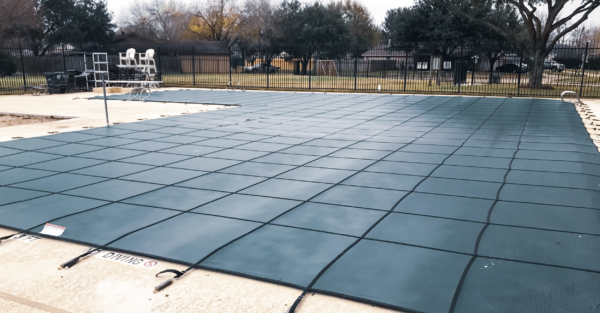 A winter pool cover is an important part of an annual pool maintenance program. After the pool season, an uncovered pool is an invitation for surface staining and other problems. An uncovered or improperly covered pool is more vulnerable to staining because there is no filtration or steady chemical treatment during the off-season. Prevent staining on your pool surface and extend its life by taking the necessary steps to ensure that your pool is properly covered during the colder months.
A winter pool cover is an important part of an annual pool maintenance program. After the pool season, an uncovered pool is an invitation for surface staining and other problems. An uncovered or improperly covered pool is more vulnerable to staining because there is no filtration or steady chemical treatment during the off-season. Prevent staining on your pool surface and extend its life by taking the necessary steps to ensure that your pool is properly covered during the colder months.
Choose the Right Safety Pool Cover
Safety pool covers are best for preventing pool staining; these custom fitted covers are made of heavy duty mesh or a solid material. When practical, solid covers are ideal because they block rain, debris, and sunlight completely. Without sunlight and organic material to feed, algae can’t bloom. Solid covers are heavy and require their own winter maintenance, therefore they may not work for larger pools without onsite staff. Mesh safety covers still block a good amount of light and most debris, making them a good compromise.
Cheaper pool covers are more susceptible to rips and punctures because they aren’t as thick and are made of a lower quality material.
Proper Installation
In addition to investing in a sturdy winter pool cover, proper measurement and installation is an equally important factor when it comes to preventing surface staining. Make sure that there are no gaps between the pool cover and the pool walls. Any gaps can serve as potential entry points for leaf debris, dirt, and other contaminants that can lead to staining. An existing pool cover may require maintenance or adjustments, so it’s best to have pool professionals install your facility’s pool cover for the off-season. This way, proper installation is guaranteed. With proper installation your pool will have the best protection.
Keep the Pool Cover Clean
It’s important to properly maintain your pool cover throughout the winter and fall. Remove debris and liquids that accumulate on the pool cover over time. As leaves begin to fall, a pool skimmer or a leaf brush can be used to remove leaves from the cover. Promptly pump rain and snow off of the pool cover to remove excess build-up. A commercial pool should consider a winter care program to help maintain the cover throughout the winter season.
Additional Ways to Prevent Staining
Covering your pool properly is an important strategy in preventing surface staining, but it isn’t the only option that should be considered. Pairing a winter pool cover with properly treated pool water is the best combination to prevent stains during the off-season.
Clean the Pool Before Covering
Your facility’s pool needs to be thoroughly cleaned before covering it. Any lingering debris can can contribute to staining during the off-season.
Maintain Balanced Water
Test all chemical levels of the pool before covering. If any chemicals are not at their proper levels, balance them. Unbalanced pool water that hasn’t been circulating or filtered can add to the build-up of contaminants and therefore staining. If the water is scale forming, deposits can form on the surface that will be hard to remove in the spring.
Additional Water Treatments
In addition to balancing your pool water, adding a stain and scale preventative can also be helpful. These preventatives help control metals and minerals in the pool water which can lead to staining. Chemical treatments that prevent algae growth should also be used so that the water stays clear under the pool cover.
Surface staining is a natural occurrence that can happen during the off-season. Combat pool stains with preventative measures and investing in a sturdy winter pool cover, that’s properly installed. To ensure that the proper measures are taken to prevent staining, it’s best to let your local pool professionals handle the job. If your facility is in need of pool professionals, American Pool is here to help! Contact us to set up a consultation.




